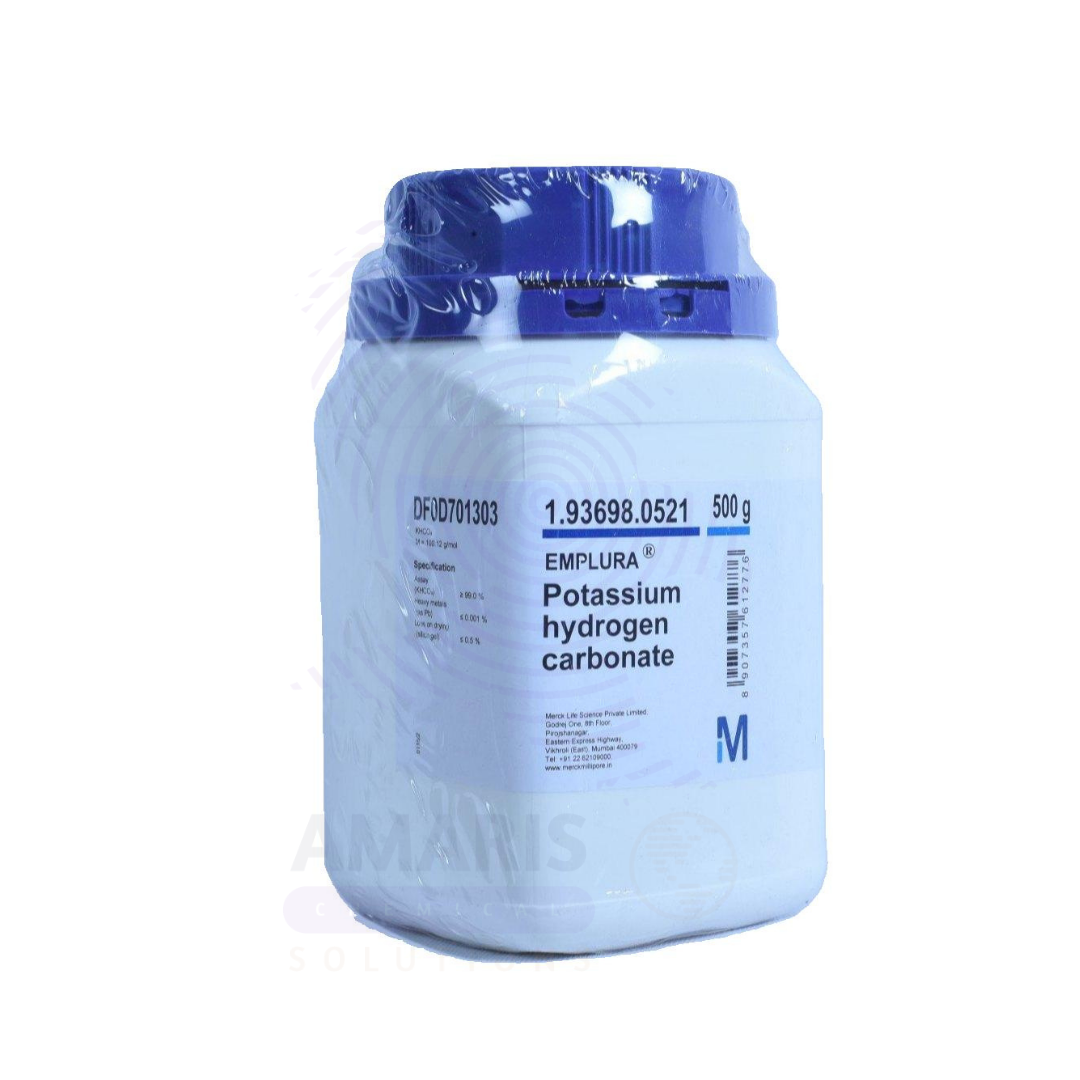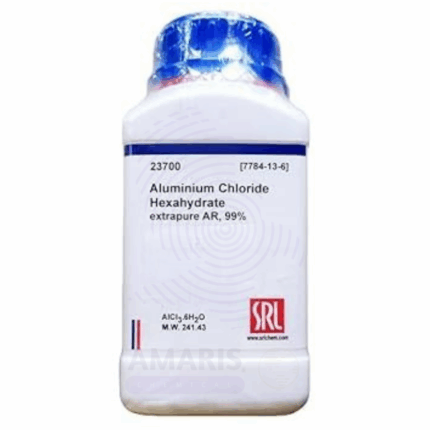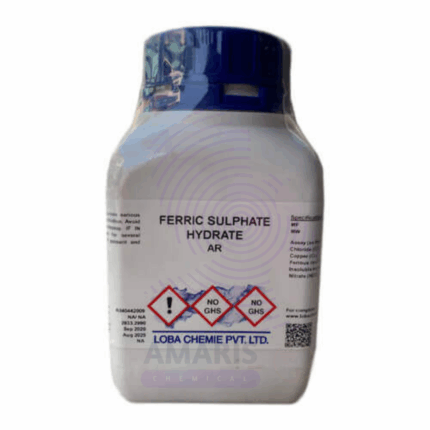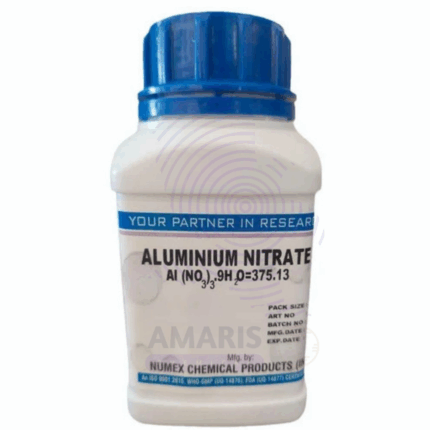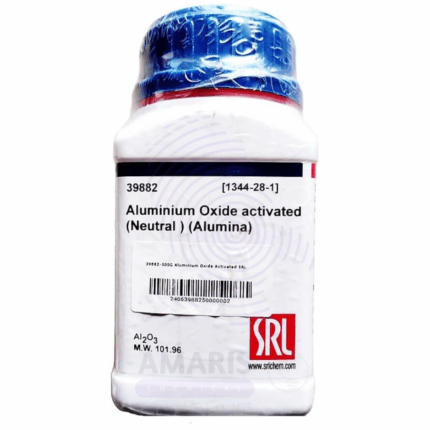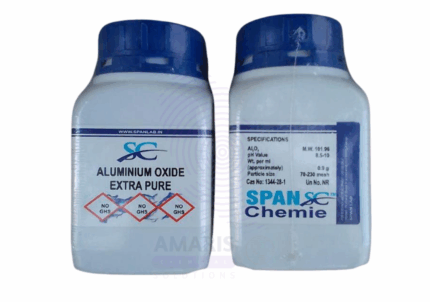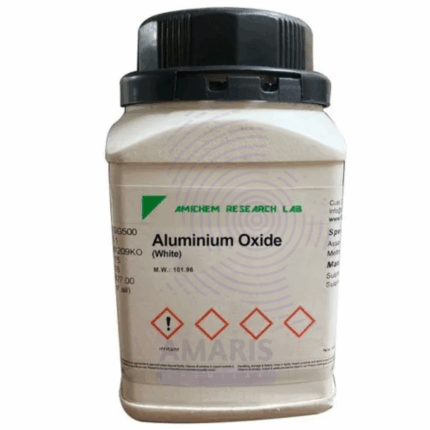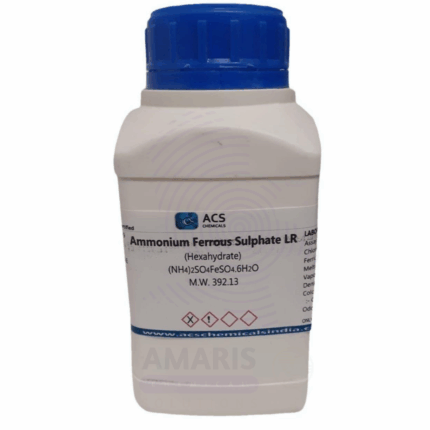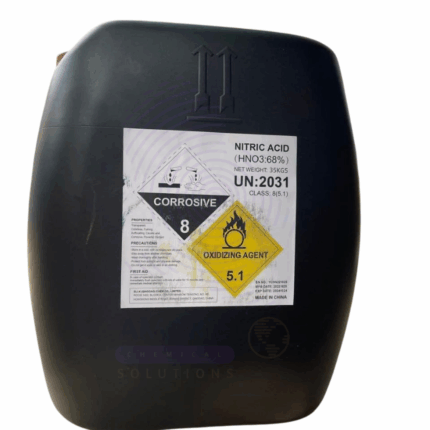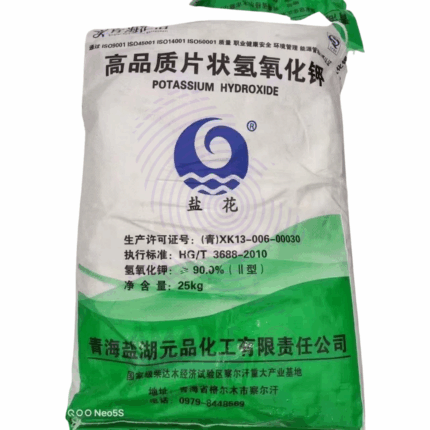
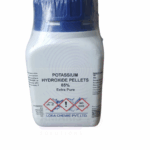
Potassium Hydrogen Carbonate Extra Pure
$ 19.11 Original price was: $ 19.11.$ 18.98Current price is: $ 18.98.
Potassium Hydrogen Carbonate Extra Pure, also known as potassium bicarbonate, is a fine white crystalline powder with excellent purity and stability. It is commonly used in laboratories as a buffering agent due to its mild alkalinity. In food processing, it functions as a leavening agent and pH regulator, and in agriculture, it is applied as a fungicide and a source of potassium. Its high solubility in water and non-toxic nature make it a versatile and safe compound for a range of analytical and technical applications. Proper storage in tightly sealed containers, away from moisture and acids, ensures optimal shelf life and performance.
Potassium Hydrogen Carbonate Extra Pure
PRIMARY USES
- Food Industry (E501):
- Used as a leavening agent in baking powders, where it releases carbon dioxide to help dough rise.
- Acts as a buffering agent to control pH in various food products.
- Fire Extinguishers:
- Commonly used in dry chemical fire extinguishers (especially Purple-K) for Class B and C fires (flammable liquids and electrical equipment).
- Agriculture & Horticulture:
- Serves as a potassium source in fertilizers to improve plant health.
- Used as a fungicide for controlling powdery mildew and other fungal infections on crops.
- Laboratory Applications:
- Functions as a mild base or buffering agent in chemical experiments and titrations.
- Used to prepare standard solutions and for pH control.
SECONDARY USES
- Pharmaceutical Industry:
- Used in antacid formulations to neutralize stomach acid.
- Sometimes found in electrolyte replacement therapies.
- Water Treatment:
- Helps adjust pH in water systems and aquatic environments.
- Beverage Industry:
- Occasionally used to regulate acidity in certain beverages, particularly sparkling drinks.
1. Basic Identification Attributes
- Chemical Name: Potassium Hydrogen Carbonate
- CAS Number: 298-14-6
- HS Code: 2836.40.00
- Molecular Formula: KHCO₃
- Synonyms:
- Potassium bicarbonate
- Monopotassium carbonate
- Acid potassium carbonate
- Potassium acid carbonate
2. Physical & Chemical Properties
- Physical State: Solid (crystalline powder or granules)
- Color & Odor: White, odorless
- Boiling Point & Melting Point:
- Decomposes on heating (>100 °C); no true boiling point
- Melting Point: Decomposes before melting (releases CO₂)
- Density/Specific Gravity: ~2.17 g/cm³
- Solubility:
- Soluble in water (~22 g/100 mL at 20 °C)
- Insoluble in alcohol
- pH Level: ~8.3 (1% aqueous solution)
- Vapor Pressure & Volatility: Non-volatile
- Flash Point: Not flammable
- Autoignition Temperature: Not applicable
- Viscosity: Not applicable (solid)
3. Safety & Hazard Attributes
- Hazard Class (GHS Classification):
- Not classified as hazardous
- Generally considered safe under normal handling
- NFPA Ratings:
- Health: 1
- Flammability: 0
- Reactivity: 0
- Exposure Limits:
- No OSHA PEL or ACGIH TLV assigned
- Reactivity:
- Stable under normal conditions
- Decomposes under heat to form potassium carbonate, water, and carbon dioxide
4. Storage & Handling Attributes
- Storage Conditions:
- Store in a dry, cool place
- Keep containers tightly closed
- Incompatible Materials:
- Acids (release CO₂)
- Strong oxidizers
- Container Type:
- Plastic or glass containers
- Shelf Life & Expiration Date:
- Stable for years under dry storage conditions
- Special Handling Requirements:
- Minimal PPE; use gloves and eye protection if handling large quantities
5. Regulatory & Compliance Attributes
- Regulatory Status:
- GRAS (Generally Recognized As Safe) by FDA
- Listed in TSCA and REACH
- Used as a food additive (E501(ii))
- Hazard Symbols (GHS Pictograms):
- None required
- Transportation Restrictions:
- Not regulated for transport
- Waste Disposal Method:
- Dispose of in accordance with local and national regulations
- Can be diluted and washed into wastewater systems
6. Environmental & Health Impact
- Ecotoxicity:
- Low toxicity to aquatic organisms
- Persistence in Environment:
- Breaks down into naturally occurring ions
- Carcinogenicity/Mutagenicity:
- Not classified as carcinogenic or mutagenic
- Biodegradability:
- Inorganic compound; not biodegradable but environmentally benign
SAFETY PRECAUTIONS
Personal Protective Equipment (PPE):
- Safety goggles or face shield
- Lab coat and chemical-resistant gloves (e.g., nitrile)
- Dust mask or respirator in case of powder handling
- Closed-toe shoes in laboratory settings
Handling:
- Avoid generating dust; use it with adequate ventilation.
- Do not inhale dust or ingest the substance.
- Handle with clean, dry equipment.
- Wash hands thoroughly after handling.
Storage:
- Store in a tightly sealed container in a cool, dry, well-ventilated area.
- Keep away from acids and moisture.
- Store separately from incompatible materials such as strong acids.
FIRST AID MEASURES
Inhalation:
- Move people to fresh air.
- Seek medical attention if breathing becomes difficult or irritation occurs.
Skin Contact:
- Wash thoroughly with soap and water.
- Remove contaminated clothing.
- Seek medical help if irritation persists.
Eye Contact:
- Rinse immediately with plenty of water for at least 15 minutes.
- Remove contact lenses if present and easy to do.
- Get medical attention if discomfort continues.
Ingestion:
- Rinse mouth with water.
- Do not induce vomiting.
- Seek medical advice, especially if large amounts are ingested.
FIRE FIGHTING MEASURES
Flammability:
- Non-flammable and not combustible.
Extinguishing Media:
- Use media suitable for surrounding fire (water spray, dry chemical, CO₂, or foam).
Hazardous Combustion Products:
- May release carbon dioxide (CO₂) and potassium oxides upon thermal decomposition.
Firefighter Protection:
- Wear full protective clothing and self-contained breathing apparatus (SCBA).
- Avoid inhaling decomposition products.


 Preservatives(food)
Preservatives(food) Flavor Enhancers
Flavor Enhancers Acidulants
Acidulants Sweeteners
Sweeteners Antioxidants
Antioxidants Colorants(food)
Colorants(food) Nutraceutical Ingredients (food)
Nutraceutical Ingredients (food) Nutrient Supplements
Nutrient Supplements Emulsifiers
Emulsifiers
 Collectors
Collectors Dust Suppressants
Dust Suppressants Explosives and Blasting Agents
Explosives and Blasting Agents Flocculants and Coagulants
Flocculants and Coagulants Frothers
Frothers Leaching Agents
Leaching Agents pH Modifiers
pH Modifiers Precious Metal Extraction Agents
Precious Metal Extraction Agents
 Antioxidants(plastic)
Antioxidants(plastic) Colorants (Pigments, Dyes)
Colorants (Pigments, Dyes) Fillers and Reinforcements
Fillers and Reinforcements Flame Retardants
Flame Retardants Monomers
Monomers Plasticizers
Plasticizers Polymerization Initiators
Polymerization Initiators Stabilizers (UV, Heat)
Stabilizers (UV, Heat)
 Antifoaming Agents
Antifoaming Agents Chelating Agents
Chelating Agents Coagulants and Flocculants
Coagulants and Flocculants Corrosion Inhibitors
Corrosion Inhibitors Disinfectants and Biocides
Disinfectants and Biocides Oxidizing Agents
Oxidizing Agents pH Adjusters
pH Adjusters Scale Inhibitors( water)
Scale Inhibitors( water)
 Antioxidants(cosmetic)
Antioxidants(cosmetic) Emollients
Emollients Fragrances and Essential Oils
Fragrances and Essential Oils Humectants
Humectants Preservatives
Preservatives Surfactants(cosmetic)
Surfactants(cosmetic) Thickeners
Thickeners UV Filters
UV Filters
 Fertilizers
Fertilizers Soil Conditioners
Soil Conditioners Plant Growth Regulators
Plant Growth Regulators Animal Feed Additives
Animal Feed Additives Biostimulants
Biostimulants Pesticides (Herbicides, Insecticides, Fungicides)
Pesticides (Herbicides, Insecticides, Fungicides)
 Active Pharmaceutical Ingredients (APIs)
Active Pharmaceutical Ingredients (APIs) Excipients
Excipients Solvents(pharmaceutical)
Solvents(pharmaceutical) Antibiotics
Antibiotics Antiseptics and Disinfectants
Antiseptics and Disinfectants Vaccine Adjuvants
Vaccine Adjuvants Nutraceutical Ingredients (pharmaceutical)
Nutraceutical Ingredients (pharmaceutical) Analgesics & Antipyretics
Analgesics & Antipyretics
 Analytical Reagents
Analytical Reagents Solvents(lab)
Solvents(lab) Chromatography Chemicals
Chromatography Chemicals Spectroscopy Reagents
Spectroscopy Reagents microbiology-and-cell-culture-reagents
microbiology-and-cell-culture-reagents Molecular Biology Reagents
Molecular Biology Reagents Biochemical Reagents
Biochemical Reagents Inorganic and Organic Standards
Inorganic and Organic Standards Laboratory Safety Chemicals
Laboratory Safety Chemicals Specialty Laboratory Chemicals(Special Laboratory Equipment)
Specialty Laboratory Chemicals(Special Laboratory Equipment)
 Demulsifiers
Demulsifiers Hydraulic Fracturing Fluids
Hydraulic Fracturing Fluids Scale Inhibitors(oil)
Scale Inhibitors(oil) Surfactants(oil)
Surfactants(oil) Drilling Fluids
Drilling Fluids
 Dyes and Pigments
Dyes and Pigments Bleaching Agents
Bleaching Agents Softening Agents
Softening Agents Finishing Agents
Finishing Agents Antistatic Agents
Antistatic Agents
 Admixtures
Admixtures Waterproofing Agents
Waterproofing Agents Sealants and Adhesives
Sealants and Adhesives Curing Compounds
Curing Compounds Concrete Repair Chemicals
Concrete Repair Chemicals Anti-Corrosion Coatings
Anti-Corrosion Coatings
 Surfactants(cleaning)
Surfactants(cleaning) Builders
Builders Enzymes
Enzymes Solvents (Cleaning)
Solvents (Cleaning) Fragrances
Fragrances
 Electronic Chemicals
Electronic Chemicals Catalysts
Catalysts Lubricants
Lubricants Photographic Chemicals
Photographic Chemicals Refrigerants
Refrigerants Automotive chemicals
Automotive chemicals Pyrotechnic Chemicals
Pyrotechnic Chemicals
 Biodegradable Surfactants
Biodegradable Surfactants Bio-based Solvents
Bio-based Solvents Renewable Polymers
Renewable Polymers Carbon Capture Chemicals
Carbon Capture Chemicals Wastewater Treatment Chemicals
Wastewater Treatment Chemicals
 Pigments
Pigments Solvents(paint)
Solvents(paint) Specialty Coatings
Specialty Coatings Binders/Resins
Binders/Resins Additives
Additives Driers
Driers Anti-Corrosion Agents
Anti-Corrosion Agents Functional Coatings
Functional Coatings Application-Specific Coatings
Application-Specific Coatings
 Fresh Herbs
Fresh Herbs Ground Spices
Ground Spices Whole Spices
Whole Spices Spice Blends
Spice Blends Dried Herbs
Dried Herbs
 Leavening Agents
Leavening Agents Dough Conditioners
Dough Conditioners Flour Treatments
Flour Treatments Fat Replacers
Fat Replacers Decoratives
Decoratives Preservatives(baking)
Preservatives(baking)
 Plasticizers & Softeners
Plasticizers & Softeners Reinforcing Agents
Reinforcing Agents Adhesion Promoters
Adhesion Promoters Vulcanizing Agents
Vulcanizing Agents Antidegradants
Antidegradants Blowing Agents
Blowing Agents Fillers & Extenders
Fillers & Extenders Accelerators & Retarders
Accelerators & Retarders